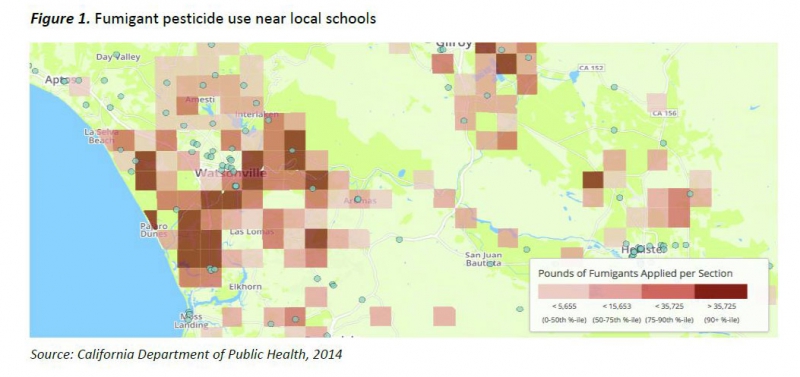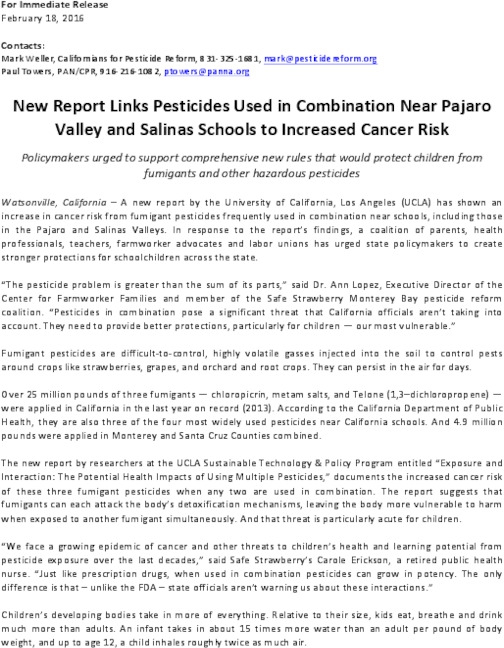From the Open-Publishing Calendar
From the Open-Publishing Newswire
Indybay Feature
California
Santa Cruz Indymedia
Education & Student Activism
Environment & Forest Defense
Health, Housing & Public Services
New Report Links Pesticides Used in Combination Near Schools to Increased Cancer Risk
Watsonville, California, February 18, 2016 – A new report by the University of California, Los Angeles (UCLA) has shown an increase in cancer risk from fumigant pesticides frequently used in combination near schools, including those in the Pajaro and Salinas Valleys. In response to the report’s findings, a coalition of parents, health professionals, teachers, farmworker advocates and labor unions has urged state policymakers to create stronger protections for schoolchildren across the state.
“The pesticide problem is greater than the sum of its parts,” said Dr. Ann Lopez, Executive Director of the Center for Farmworker Families and member of the Safe Strawberry Monterey Bay pesticide reform coalition. “Pesticides in combination pose a significant threat that California officials aren’t taking into account. They need to provide better protections, particularly for children — our most vulnerable.”
Fumigant pesticides are difficult-to-control, highly volatile gasses injected into the soil to control pests around crops like strawberries, grapes, and orchard and root crops. They can persist in the air for days.
Over 25 million pounds of three fumigants — chloropicrin, metam salts, and Telone (1,3–dichloropropene) — were applied in California in the last year on record (2013). According to the California Department of Public Health, they are also three of the four most widely used pesticides near California schools. And 4.9 million pounds were applied in Monterey and Santa Cruz Counties combined.
The new report by researchers at the UCLA Sustainable Technology & Policy Program entitled “Exposure and Interaction: The Potential Health Impacts of Using Multiple Pesticides,” documents the increased cancer risk of these three fumigant pesticides when any two are used in combination. The report suggests that fumigants can each attack the body’s detoxification mechanisms, leaving the body more vulnerable to harm when exposed to another fumigant simultaneously. And that threat is particularly acute for children.
“We face a growing epidemic of cancer and other threats to children’s health and learning potential from pesticide exposure over the last decades,” said Safe Strawberry’s Carole Erickson, a retired public health nurse. “Just like prescription drugs, when used in combination pesticides can grow in potency. The only difference is that – unlike the FDA – state officials aren’t warning us about these interactions.”
Children’s developing bodies take in more of everything. Relative to their size, kids eat, breathe and drink much more than adults. An infant takes in about 15 times more water than an adult per pound of body weight, and up to age 12, a child inhales roughly twice as much air.
UCLA researchers are also quick to point out that “interactive effects from [fumigants] and other pesticides may also increase the risk of other human health problems, including those related to developmental, reproductive, and neurotoxicity.”
Members of Safe Strawberry Monterey Bay, a local coalition of parents, health professionals, teachers, farmworker advocates and labor unions, called on state and local officials to accept their responsibility to protect children from pesticides linked to cancer and other serious health harms. The California Department of Pesticide Regulation is mandated by the state to consider real-world and cumulative exposures to pesticides. And right now, over 500,000 California schoolchildren attend schools near highly hazardous pesticide use—more than 18,000 in Monterey County alone. A disproportionate number of these impacted children are Latino.
“State and local officials have failed to provide even the most minimal rules for pesticides used near schoolchildren,” said Pajaro Valley schoolteacher, Francisco Rodriguez. “We see these fumigants used in combination near Pajaro and Salinas Valley Schools all the time. New rules must at least make one mile no-spray or no-fumigation zones around schools, to reduce the risk of exposure to the most hazardous pesticides, alone or in combination.”
Officials at the Department of Pesticide Regulation have indicated they will consider rules to restrict hazardous pesticide use near schools as early as next month. Members of Safe Strawberry and the statewide coalition Californians for Pesticide Reform, along with allies such as the California Teachers Association and California Federation of Teachers, are pressing for permanent one-mile no-spray zones around schools for the most hazardous agricultural pesticides, as well as additional restrictions on aerial, fumigation and air blaster applications — and better notification around proposed applications to parents and teachers.
Californians for Pesticide Reform (CPR) is a statewide coalition of more than 190 organizations, founded in 1996 to fundamentally shift the way pesticides are used in California. CPR's mission is to protect public health, improve environmental quality and expand a sustainable and just agriculture system by building a diverse movement across California to change statewide and local pesticide policies and practices.
http://www.pesticidereform.org/
Fumigant pesticides are difficult-to-control, highly volatile gasses injected into the soil to control pests around crops like strawberries, grapes, and orchard and root crops. They can persist in the air for days.
Over 25 million pounds of three fumigants — chloropicrin, metam salts, and Telone (1,3–dichloropropene) — were applied in California in the last year on record (2013). According to the California Department of Public Health, they are also three of the four most widely used pesticides near California schools. And 4.9 million pounds were applied in Monterey and Santa Cruz Counties combined.
The new report by researchers at the UCLA Sustainable Technology & Policy Program entitled “Exposure and Interaction: The Potential Health Impacts of Using Multiple Pesticides,” documents the increased cancer risk of these three fumigant pesticides when any two are used in combination. The report suggests that fumigants can each attack the body’s detoxification mechanisms, leaving the body more vulnerable to harm when exposed to another fumigant simultaneously. And that threat is particularly acute for children.
“We face a growing epidemic of cancer and other threats to children’s health and learning potential from pesticide exposure over the last decades,” said Safe Strawberry’s Carole Erickson, a retired public health nurse. “Just like prescription drugs, when used in combination pesticides can grow in potency. The only difference is that – unlike the FDA – state officials aren’t warning us about these interactions.”
Children’s developing bodies take in more of everything. Relative to their size, kids eat, breathe and drink much more than adults. An infant takes in about 15 times more water than an adult per pound of body weight, and up to age 12, a child inhales roughly twice as much air.
UCLA researchers are also quick to point out that “interactive effects from [fumigants] and other pesticides may also increase the risk of other human health problems, including those related to developmental, reproductive, and neurotoxicity.”
Members of Safe Strawberry Monterey Bay, a local coalition of parents, health professionals, teachers, farmworker advocates and labor unions, called on state and local officials to accept their responsibility to protect children from pesticides linked to cancer and other serious health harms. The California Department of Pesticide Regulation is mandated by the state to consider real-world and cumulative exposures to pesticides. And right now, over 500,000 California schoolchildren attend schools near highly hazardous pesticide use—more than 18,000 in Monterey County alone. A disproportionate number of these impacted children are Latino.
“State and local officials have failed to provide even the most minimal rules for pesticides used near schoolchildren,” said Pajaro Valley schoolteacher, Francisco Rodriguez. “We see these fumigants used in combination near Pajaro and Salinas Valley Schools all the time. New rules must at least make one mile no-spray or no-fumigation zones around schools, to reduce the risk of exposure to the most hazardous pesticides, alone or in combination.”
Officials at the Department of Pesticide Regulation have indicated they will consider rules to restrict hazardous pesticide use near schools as early as next month. Members of Safe Strawberry and the statewide coalition Californians for Pesticide Reform, along with allies such as the California Teachers Association and California Federation of Teachers, are pressing for permanent one-mile no-spray zones around schools for the most hazardous agricultural pesticides, as well as additional restrictions on aerial, fumigation and air blaster applications — and better notification around proposed applications to parents and teachers.
Californians for Pesticide Reform (CPR) is a statewide coalition of more than 190 organizations, founded in 1996 to fundamentally shift the way pesticides are used in California. CPR's mission is to protect public health, improve environmental quality and expand a sustainable and just agriculture system by building a diverse movement across California to change statewide and local pesticide policies and practices.
http://www.pesticidereform.org/
Add Your Comments
We are 100% volunteer and depend on your participation to sustain our efforts!
Get Involved
If you'd like to help with maintaining or developing the website, contact us.
Publish
Publish your stories and upcoming events on Indybay.
Topics
More
Search Indybay's Archives
Advanced Search
►
▼
IMC Network




